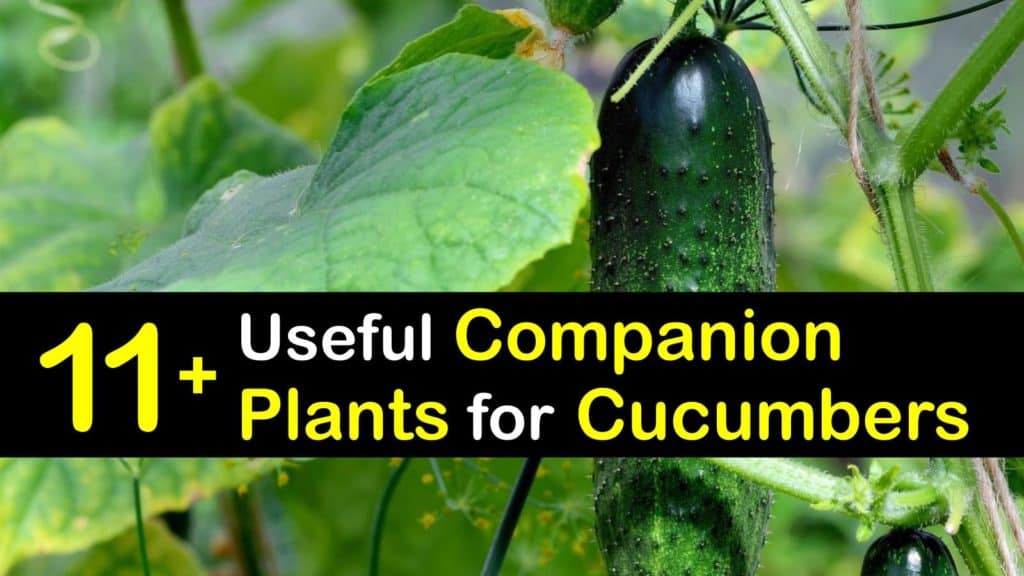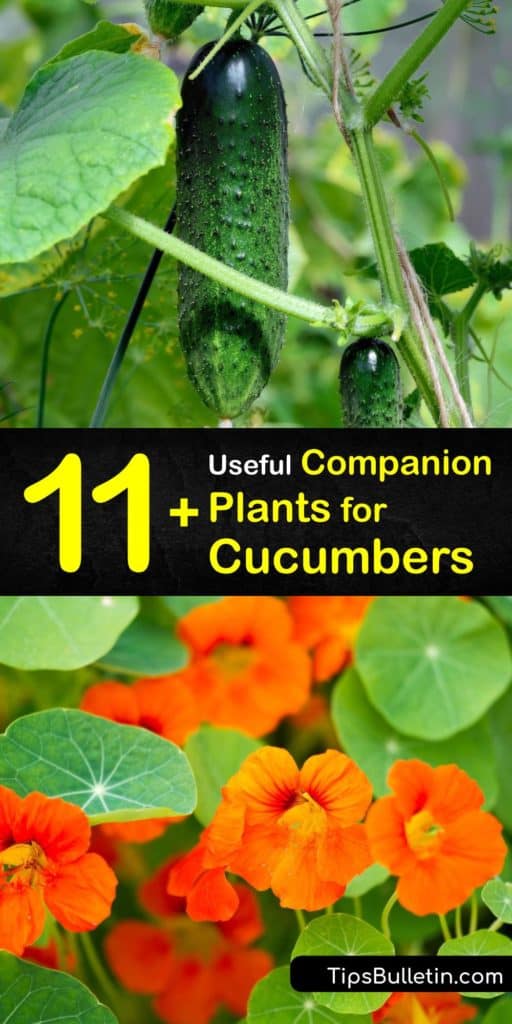Cucumbers are an easy and rewarding crop to grow in your vegetable garden. Use companion planting to help your cucumber plants grow strong and healthy. In this article, you’ll discover why companion planting cucumbers with various other veggies, aromatic herbs, and flowers allows you to enjoy an even more delicious and plentiful harvest of cukes.
Companion planting is a helpful garden design technique that utilizes certain plants’ mutually beneficial qualities to create a healthy garden ecosystem.
Some plants attract pollinators and beneficial predatory insects, while others repel garden pests. Numerous plants reportedly support one another’s growth and produce better tasting fruit when grown nearby.

What to Plant with Cucumbers to Repel Pests
When choosing what to plant with cucumbers, there are a few key factors to keep in mind. Cucumbers tend to grow long, sprawling vines. It is possible to train them to grow on a trellis to conserve space in the garden.
They have shallow root systems, so root crops like carrots, turnips, parsnips, and radishes make good companions. Cucumbers prefer to grow in full sun and need at least six hours of direct sunlight each day.
Although cucumbers are generally easy to grow and harvesting cucumbers is exciting, a few insect pests frequently cause gardeners problems.
Some of the most commonplace garden pests that attack cucumber plants include aphids, cucumber beetles, thrips, and whiteflies. Interplanting aromatic herbs and flowers in your cucumber patch when you grow cucumbers from seeds or seedlings helps to keep these pests away.
Learning how far apart to plant cucumber seeds also helps deter bugs and disease and prevents yellow spots on cucumber leaves as well as loss of leaves.
Alliums
Members of the allium family include chives, garlic, onions, leeks, and shallots as well as ornamental allium flowers. Cucumber grows well with garlic.
These plants’ strong scent repels deer and rodents in addition to insect pests like aphids, armyworms, borers, carrot flies, caterpillars, slugs, spider mites, and whiteflies.
Avoid planting members of the allium family near legumes like beans and peas. These plants reportedly stunt one another’s growth.
Catnip
Catnip belongs to the mint family. Its strong scent repels a wide variety of garden pests, including aphids, ants, beetles, cabbage loopers, cockroaches, and weevils. It also deters larger pests like rodents and deer from raiding your veggies.
Catnip spreads vigorously and may become invasive in some growing climates. To avoid letting it spread, plant catnip in a container with drain holes and either bury it in the soil or place the pot near your cucumber plant.

Keep in mind that you can also take care of growing cucumbers in a container. Place your catnip pots near your cucumber pots to take advantage of companion planting.
Marigold
Marigolds are one of the most popular flowers for companion planting. They effectively repel pests like aphids, bean beetles, cucumber beetles, cabbage worms, squash bugs, thrips, tomato hornworms, and whiteflies.
Also, their roots contain a natural chemical that kills harmful root-knot nematodes that attack other plant roots.
Nasturtium
Nasturtiums are attractive flowering plants, and they are edible, too. The leaves and flowers have a strong, slightly peppery flavor. They repel cucumber beetles, cabbage loopers, squash bugs, and whiteflies.
Some gardeners use nasturtiums as a trap crop for aphids, planting them a short distance away from their preferred varieties. The aphids prefer nasturtiums and will do far less damage to the other plants.
Oregano
Plant oregano near your cucumbers to repel ants, cucumber beetles, and cabbage moths. This wonderful herb also attracts pollinators and provides habitat for beneficial predatory insects like lacewings.
Keep in mind that oregano is a spreading perennial and freely reseeds itself. Remove the spent flowers before they have a chance to go to seed and cut the plant back regularly to control its growth.
Tansy
Tansy is a good companion for cucumbers because it repels cucumber beetles, cutworms, Japanese beetles, mosquitoes, squash bugs, and sugar ants as well as rodents and deer. The bright yellow, button-like flowers are also a pollinator favorite.
Tansy helps to concentrate potassium in the nearby soil. Potassium is an essential macronutrient that promotes the fruiting and flowering processes in plants.
Attract Beneficial Insects by Companion Planting for Cucumbers
Insects play an essential role in a healthy garden, from pollinating flowers to preying on garden pests.
Various herbs and flowers attract pollinators like bees and butterflies. In contrast, others act as a host plant for predatory insects like ladybugs and lacewings to lay their eggs.
The best way to plant cucumber seeds is to plan in advance what plants you will grow nearby to ensure a healthy environment.
Borage
Borage is widely considered to be one of the best companion plants for the vegetable garden. Tender young borage leaves and flowers are edible.
They have a sweet, cucumber-like flavor. Pollinators love the blue star-shaped flowers. The leaves act as a habitat for predatory insects like lacewings and parasitic wasps to lay their eggs.
Borage also reportedly improves cucumbers’ flavor and helps its neighboring plants be more resilient and recover more quickly from environmental stress.
Large borage leaves are useful as mulch around the vegetable garden. As they break down, they add valuable nitrogen and other nutrients to the soil.
Borage is a large, fast-growing plant that readily self-seeds, so be sure to keep its space requirements in mind when choosing a growing location. Remove spent flowers if you do not wish to see volunteer seedlings next season.
Cilantro/Coriander
Cilantro is an excellent companion plant for many reasons. It serves as a host for beneficial predatory insects like lacewings, ladybugs, hoverflies, and parasitic wasps to lay their eggs. The dainty white flowers attract pollinators to the garden.
The herb’s strong scent also repels garden pests like aphids, spider mites, and potato beetles.
The feathery cilantro leaves do not block much light, so it is an excellent choice for planting throughout your vegetable garden. Cilantro is slower to bolt when it receives some shade from tall plants as the weather gets hotter.
Chamomile
Just like chamomile tea is soothing, the plant helps you maintain a healthier garden, too. Chamomile attracts numerous beneficial insects, including pollinators and predators like lacewings, ladybugs, and hoverflies.
Chamomile is naturally antibacterial and antifungal. Growing this herb near other plants helps them to be more disease-resistant.
Chamomile tea is beneficial for plants as well. Use it as a foliar spray to combat plant disease. It also works as a contact insecticide against soft-bodied insects like aphids, thrips, whiteflies, and mites without harming beneficial insects like bees and ladybugs.
Bring a cup of tap water to a rolling boil and allow the chamomile to steep for at least 24 hours. Pour the tea into a clean spray bottle and spray any plants that are infested with garden pests or suffering from bacterial or fungal disease.
Dill
Dill makes a delicious addition to your herb garden and is excellent for attracting beneficial insects.
The umbrella-like flowers and feathery leaves are a favorite for pollinators and predatory insects like ladybugs, lacewings, tachinid flies, hoverflies, and parasitic wasps.
Dill reportedly affects the flavor of cucumbers when planted nearby. If you do not enjoy the flavor of dill, plant it in a separate area of the garden to enjoy the companion planting benefits without having dill-flavored cucumbers.
Hyssop
This beautiful flowering perennial in the mint family does double duty in the garden. It is a pollinator favorite and acts as a host plant for other beneficial insects like ladybugs and hoverflies.
The strong scent of hyssop also deters cabbage moths, flea beetles, slugs, deer, and rodents.
Companion Planting Cucumbers for Mutual Benefits
Certain plants are suitable candidates when companion planting for cucumbers because they have compatible growth habits, water and nutrient requirements, or another factor that helps the surrounding plants grow healthier.
For example, leafy greens act as a living mulch and benefit from the shade provided by taller plants. Tall plants with sturdy stalks like corn and sunflowers double as living trellises for cucumber vines with small, lightweight fruit.
Brassicas
Brassicas are members of the cabbage family and include bok choy, broccoli, Brussels sprouts, cabbage, cauliflower, collards, kale, kohlrabi, and turnips.
Growing collard greens or other brassicas near trellised cucumbers is a good idea because the cucumber vines provide these cool-weather crops with some much-needed shade during the hottest months. Growing turnips from seed beside your cukes is a great idea.
In return, when growing cucumbers vertically with brassicas, the plants serve as living mulch to hold in moisture and keep the soil cool and protected from wind erosion.
However, keep in mind that brassicas are heavy water users and may compete with cucumbers for available soil moisture. You’ll need to provide extra water when considering what to plant with bok choy and cucumbers.
Legumes
Legumes like beans and peas are excellent companion plants for cucumbers because they fix nitrogen in the nearby soil.
These plants have a symbiotic relationship with soil bacteria that allows them to absorb atmospheric nitrogen, which cannot be consumed by most plants and release into the soil as nitrates that other plants can use.
Interplant bush beans among your cucumber plants, or trellis peas or pole beans and cucumbers together. Growing summer savory nearby helps to deter bean beetles. Avoid growing legumes near members of the onion family, as they stunt one another’s growth.
What Not to Plant with Cucumbers
While numerous plants help cucumbers grow stronger, there are a few that make bad neighbors and should live separately. Here are several crops to keep away from different types of cucumber plants.
Fennel
Although it is excellent for attracting pollinators and other beneficial insects, fennel does not have many friends in the vegetable garden. Its roots secrete a chemical that inhibits other plants’ growth.
If you would still like to enjoy the benefits of growing fennel, keep it in a pot or its own corner of your garden.
Avoid letting it go to seed, especially if you are also growing dill. These two plants are related and may cross-pollinate, creating a strange-tasting hybrid.
Melons and Squash
Because growing cantaloupe, watermelons, zucchini, and pumpkins are in the same plant family as cucumbers, it may seem like they would be compatible.
However, they are susceptible to many of the same pest and disease problems, so what to grow with pumpkins may not be cucumbers. Growing them in separate areas of your garden helps slow the spread of these issues.
Potatoes
Members of the nightshade family, like eggplants, peppers, and tomato plants are safe to grow near cucumbers, but not potatoes. Growing cucumbers next to potatoes increases the risk of early potato blight.
When considering what to plant with cucumbers, remember that diversity is essential for creating a healthy garden ecosystem. Use this companion planting guide to select a variety of flowering plants to repel garden pests and attract beneficial insects.
Green beans fix nitrogen in the nearby soil, and marigolds secrete a chemical that kills harmful nematodes.
Ensure each type of plant gets enough sunlight by placing taller plants where they provide shade for cool-weather crops without blocking light for the ones that require full sun.

We hope you found these ideas on companion planting for cucumbers helpful, and would appreciate it if you share this article about companion planting cucumbers with your fellow gardeners on Pinterest and Facebook.